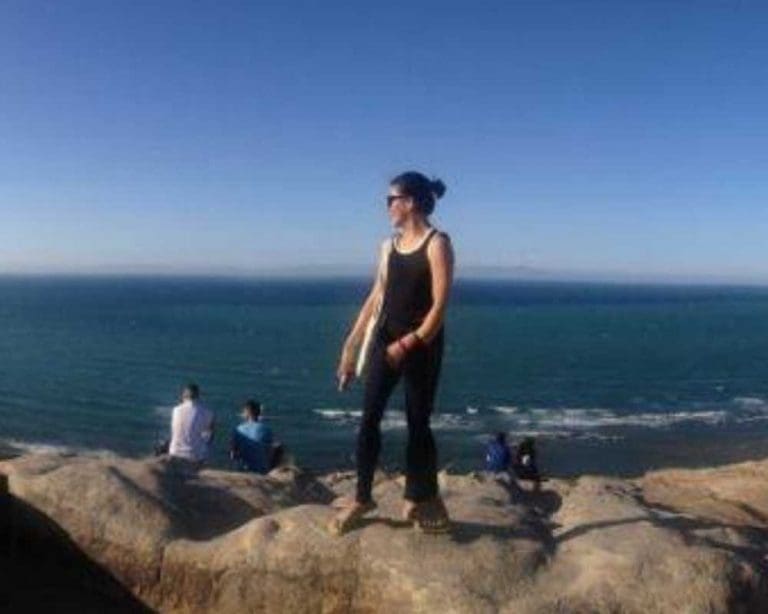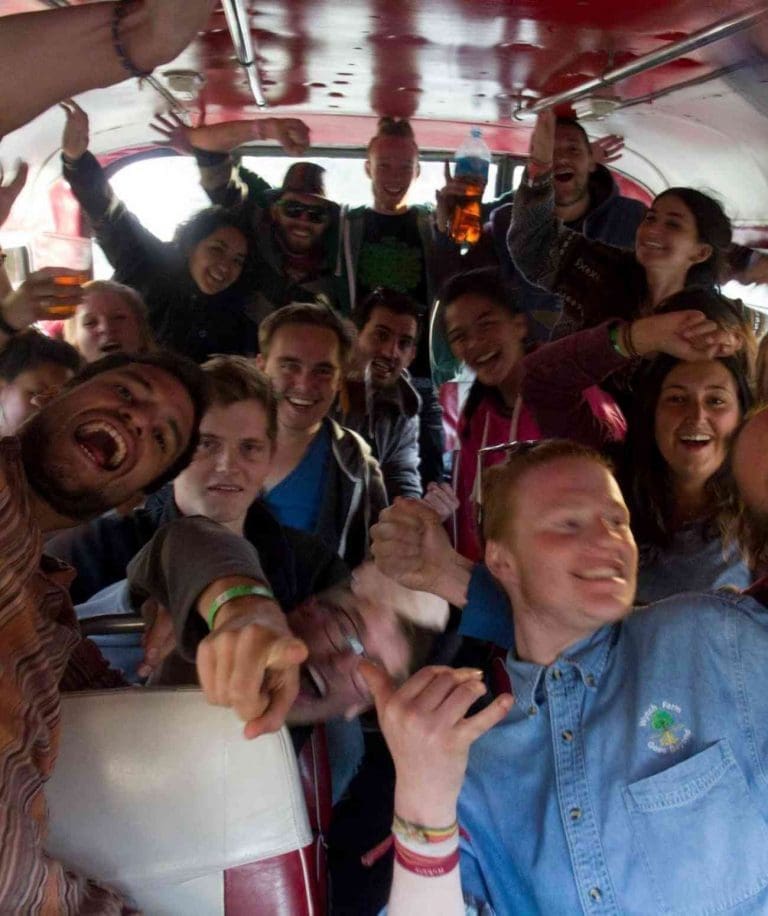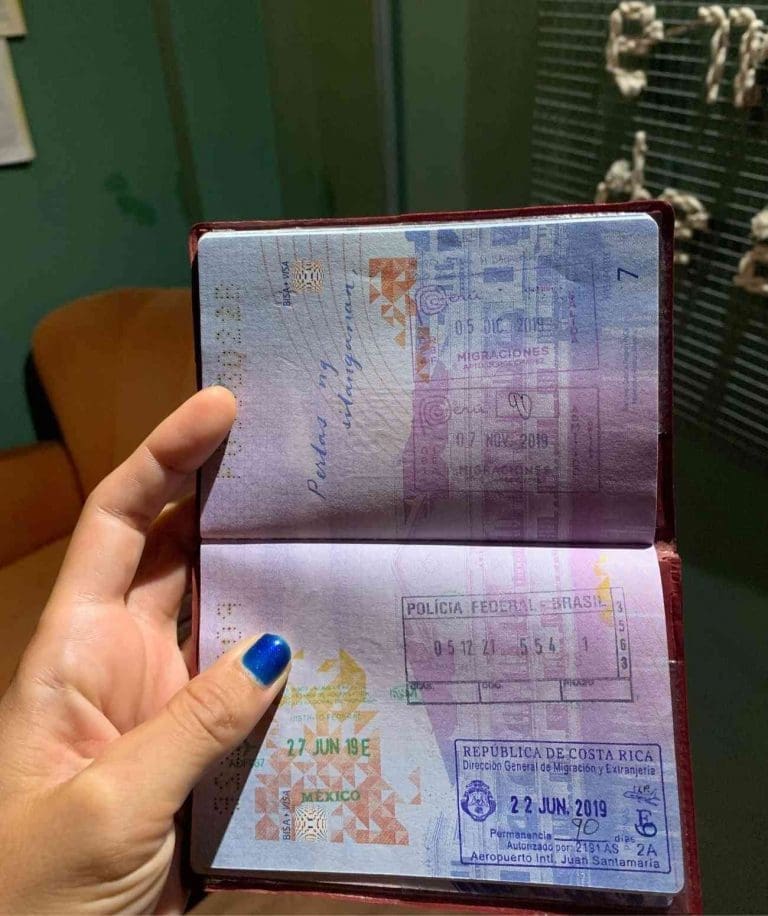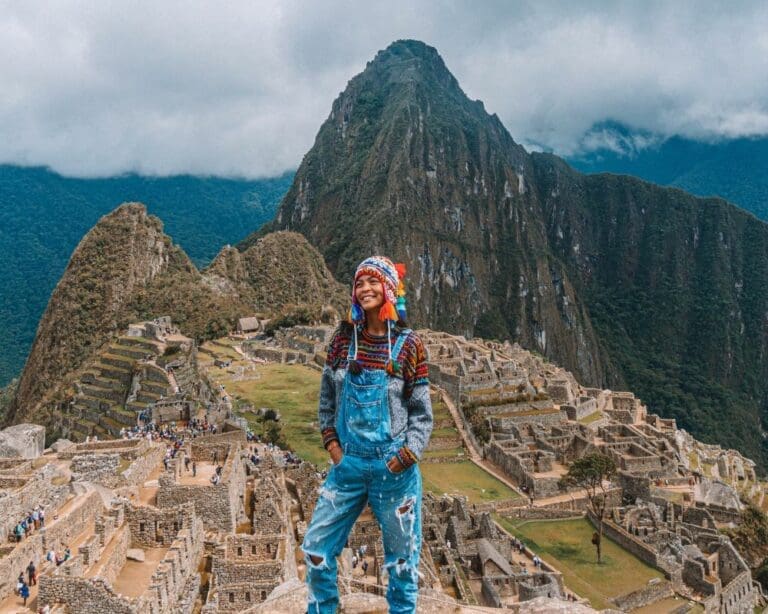South America backpacking route: my 3-year backpacking trip
This was my South America backpacking route for 3 years. Yes, I did it for 3 years! This guide is mostly for beginners but I also have advanced backpacking guides on my blog. Happy travels!
📬 Reader Mail: Hello Trisha, I love your South America adventures! I noticed that you do not have a South America backpacking route. Can you direct me to the right link? I am planning to do it next year but I do not have a clue about the route. Thank you so much!
Michael Taylor, MI, USA
Are you on a gap year? Or long-term travel? If yes, then this post is for you! I’ve navigated South America for three years, all by land. Though the continent is huge, you can get from point A to B easily and without a hassle. Please take note that this post is applicable to those who are traveling long-term aka 6 months at a minimum.
Ready to know my South America backpacking route? First, I want to tell you a little story about how I ended up backpacking South America for 3 years and why it took me that long.
My personal experience in backpacking South America for 3 years
One of the most common questions I receive about the South America backpacking route: is it hard? ABSOLUTELY NOT! You see, there are only two routes for traveling this region:
- Going up: Brasil-Uruguay-Argentina-Chile-Bolivia-Peru-Ecuador-Colombia.
- Going down: Colombia-Ecuador-Peru-Bolivia-Chile-Argentina-Uruguay-Brasil.
- I navigated my travels “going down” so, in this post, I will give you extensive information on how I did it.
Click here to see the map’s full view.
Now, a lot of people ask me this question too: “3 years?! That’s a long time!” I know you do not plan to go backpacking in South America for 3 years.
You can definitely do this for a month, a year, 2 weeks, I don’t know, it’s up to you! I did this for 3 years because, at the time, it was the opportunity presented to me.
I was 21 years old, left University, and just blindly flew to South America without thinking or planning. Then, there weren’t any guides about South America backpacking route and the Internet wasn’t that reliable.
I don’t even remember having a smartphone so imagine how lucky you are to be doing this with hundreds of guides and personal experiences like these online.
I’m sure you’re also wondering how I survived backpacking South America as a solo woman. The truth is, nothing really bad happened to me when I was doing this solo.
The South American terrain is very friendly to backpackers. Everyone’s doing the same route so you will always come across people for support.
In my experience, I met different people while doing this and I met them in different countries, too! I swear, you will see the same people more than twice that will make you feel that this is such a small region.
But it’s not. This is also one of the reasons I did it for years because I want to know this region well. Now, I can say that I know South America very well. As in very well.
Related: A realistic South America travel budget
How I financed my 3-year South America backpacking trip
You might be thinking I must have a lot of money saved in order to do this. The truth is, I didn’t. One of the major things that saved me a lot of money on this backpacking trip is doing volunteer work.
Meaning, I worked in hostels in exchange for free accommodations and food. I am not saying you should do the same but this led me to meet different people from different countries and also get to master the Spanish language easily. A year on this trip, I was already fluent in Spanish!
I spent a year without paying for accommodations and I also stayed with local families. I also had online jobs and this is the time where I got serious with the blog.
I spent a lot of time improving the blog and making it a business that made me stay longer in South America. You do not have to do the same – I am just explaining to you my circumstance so you will better understand and apply it to your backpacking trip. If you want to do the same, you can refer to my article, jumpstart your career as a digital nomad and start working for yourself!
South America visas, entry/exit requirements, etc
As a Philippine passport holder, I am not 100% visa-free in all South American countries but in the majority of it, I didn’t need a visa to enter.
For the most part, since I was traveling non-stop (without going back to the Philippines), I applied for visas to Chile, Argentina, and Uruguay at the borders.
I didn’t encounter any problems but it just took some time. I was also traveling by land and I guess it’s easier to obtain visas at land crossings.
Since Brazil was part of my trip and actually one of the first countries I’ve been to in South America, a yellow fever vaccine is required.
I did not have this prior to arrival in Brazil but in my experience, the majority of the South American countries require this vaccine. I got it for free in Brazil though I know many European friends who got it before they flew to South America.
South America backpacking route: the complete guide on how I did it
I started in Colombia
From Bogota, fly to the coast. Barranquilla, Santa Marta, Taganga, and Cartagena are very easy to reach as they are close to each other. The average fare from jumping into these cities is around COP45,000 ($14.45 USD).
On the coast of Colombia, minivans are the most popular mode of transportation. However, taking public busses (very uncomfortable) can cost COP10,000 less.
Amazed by the cheap flights within the country? Then don’t skip Medellin! Medellin is one of the best cities I’ve ever been in South America and you should probably want to visit it, too!
So you want to move on to Ecuador. What are your options?
- Fly from Bogota to Quito via Viva Colombia; or
- Continue traveling by land.
If you choose #2, you will have to fly to Cali, Colombia, and then from there, take the bus to Pasto, then Ipiales to Tulca. Check this article for detailed information on how to cross Colombia to Ecuador by land.
Moving on to Ecuador
Tulca is the name of the city where the border of Colombia and Ecuador meets. Before coming to Quito, you should stop in the little city of Otavalo where you can find every cheap South American/Andean piece of crafts.
You can find a wide variety of cheap finds here like ponchos and sweaters which could be useful for the rest of your trip. Busses go to Quito from Otavalo 24 hours a day and it only costs $5 USD.
💃🏽 FUN FACT: Ecuador uses US Dollar as its currency.
Quito is one of the most beautiful colonial cities in Latin America where baroque architecture is straddling the city. Climbing Cotopaxi and visiting the Mitad del Mundo (middle of the world) is one of the biggest activities in the capital.
Unfortunately, there are no cheap flights going to the north of the country from Quito. Well, it really depends what you mean about cheap but for me, cheap is $20 – $100. Anything above that is already expensive for me.
So don’t fly to Peru as you will miss the northern part of Ecuador. Guayaquil is just a city but this is the main hub of buses in the North.
From Guayaquil, you can go to Montañita (3 hours), Cuenca or Baños (6 hours). Ecuador doesn’t have impressive beaches but if you want to party hard (I mean hard), Montañita is a good option.
Take note that Montañita is also a part of the drug economy of South America. If you are not in the party mood, then don’t go. Cuenca is another beautiful colonial city that is worth visiting while the edge of the world swing is located in Baños.
Guayaquil is where you have to take the bus to enter Peru. Busses go to Mancora twice a day. Make sure you get the night bus so the hot weather will not bug you.
Mancora is really hot, most especially during the summer! Additionally, you need to stop in the border of Peru and Ecuador to do your exit/entry stamp.
There are usually no lines at night so it will be faster for you to do this. If you bought a direct ticket to Mancora, there is no need to change buses. Travel time from Guayaquil to Mancora is 8 hours.
Peru
Welcome to Mancora! Sick of the parties? Then slowly move your way to the rich coastline of Peru! Visit Chiclayo, Cajamarca and Trujillo — places where the biggest native empire (Inca) left marks of their struggle for independence against the Spanish and Europeans.
If you want to experience the jungle, Tarapoto and Iquitos (though out of route) are two of your best options. These cities are the gateway to the Amazon Jungle of Peru.
If not, simply make your way down to Huaraz and enjoy shtloads of mountain trekking/climbing and rafting activities. Huaraz is really beautiful I think you shouldn’t miss it!
From there, you can make your way to Lima. A lot of travelers say there is nothing to do in Lima but you might want to check it out. It is not only the capital of Peru but also the capital (main base) of the Spanish colonization in Latin America.
My first time visiting the city center of Lima was shocking — it looks exactly like Madrid. Give it a day or two then move to Paracas where you can do kitesurfing, visit the National Reserve and Ballestas Islands aka mini Galapagos. The travel time from Lima to Paracas: 4 hours From Paracas, it is relatively easy to make your way South:
- Paracas to Ica (approximately 1 hour): sand dune surfing in Huacachina and viewing of the Nazca lines.
- Ica to Arequipa (14 hours): Arequipa is one of the modernized slash colonial cities of Peru where the famous Colca Canyon is located. It is advisable to stay at least 5 days in Arequipa.
- Arequipa to Cusco (approximately 8 hours): Of course, you’ll spend a longer time in Cusco because of the Machu Picchu tour. I must tell you though, Cusco is more than Machu Picchu! There are a lot of other activities you can do while you are in the city. 2 weeks of stay is ideal because you need to get used to the altitude before you do any extreme activities.
- Cusco to Puno: Puno is the border of Peru and Bolivia, home to the indigenous Uros tribe.
When traveling to Peru, I highly recommend Peru Hop (PH), a first-class bus company where you can hop on/hop off in any city you choose to go.
Basically, you pay for a one-time pass that costs less than $200. Their route: Lima-Paracas-Huacachina-Arequipa-Cusco-Puno (and vice-versa).
Let’s say you purchased a pass from Lima and you want to stay in Paracas for one month. You need to inform their customer service when you will be hopping on so they can pick you up from your hostel.
Yep, you don’t need to stress in arranging your transport to the bus station nor worry about your next ticket. Additionally, they also have some free tours included in the passes! It is safe, affordable, convenient, and flexible!
If you don’t fancy PH, you can check Peru Bus Portal where you can see all the timetables of the buses traveling throughout the country. But I am sure you will like PH… because they now have Bolivia Hop, too!
Bolivia
From the border of Peru and Bolivia, the first place you will go to is Copacabana where you can spend a few days in some of its beautiful islands like Isla del Sol.
From there, buses go to La Paz every day. I spent three months in La Paz and it’s one of the most interesting periods of my life! As a capital, buses go to Potosi where Salar de Uyuni, the biggest salt flat in the world is located. You can also pass by Sucre and Santa Cruz.
Chile
If you sign up for a tour in Salar de Uyuni, they will also give you an option to cross to Chile and visit the the Atacama desert. Make your way down to Valparaiso and then Santiago (the capital). I did not include it in the map but there are two choices on how to cross Chile to Argentina:
- Direct bus from Santiago to Mendoza;
- Travel all the way down to the South of Chile, visit Patagonia, and enter Argentine Patagonia.
Fun Fact: Chile is one of the most expensive countries in South America.
Argentina
Argentina is a relatively big country so whether you opt to enter from the north or south of Chile, you will always end up in the world-class capital of Buenos Aires.
The main bus station (Retiro) is in BA and you can basically travel all over the country by land. Click here to see all the bus timetables within Argentina.
Suggested cities to visit: Rosario, Cordoba, Mendoza, Mar de Plata and San Martin de los Andes. If you have the chance, please visit the South where you can see the glaciers of Perito Moreno and the Tierra del Fuego (land of fire).
At the edge of the country, you can find Ushuaia where cruise ships to Antarctica leave!
Additional tip: Make sure you bring dollars! There are two exchange rates in Argentina (official and black market) and your US dollars can go a long way here.
How do you easily get to Uruguay from Argentina? There is a ship in Buenos Aires that goes straight to Montevideo. Travel comfortably in a first-class mini cruise ship for less than $100 USD and in just 2 hours, you will be in Uruguay!
Uruguay
Argentina is a relatively big country so whether you opt to enter from the north or south of Chile, you will always end up in the world-class capital of Buenos Aires. The main bus station (Retiro) is in BA and you can basically travel all over the country by land. Click here to see all the bus timetables within Argentina.
Places to visit in Uruguay: Isla del Diablo and Punta del Este. Please take note that Uruguay is also very expensive!
Brazil
Why, hello, Brasil! So you are already in Porto Alegre and you want to make your way up to Sao Paulo. Let’s not rush though. I highly recommend you visit the Iguazu Falls in Foz first. There are direct buses from Porto Alegre to Foz so worry not! And more good news — from Foz, you don’t have to change buses to go to Sao Paulo so you’re good. Brasil is really huge so I won’t be really giving you a definite route. Since this is the last stop, you can navigate the country by yourself!
There are a lot of beautiful places to visit in Brasil and here are my recommendations:
- The South: Paraná, Santa Catarina and Rio Grande do Sul
- Rio de Janeiro (of course!). Don’t forget Buzios and Paraty too!
- Jericoaquara
- Salvador de Baiha for capoeira and some good Brasilian food!
- The northeast: Recife, Olinda, São Luís and Fortaleza
- Matto Grosso
- Minas Gerais







Ah, I can’t wait to venture through South America! It truly is my dream. I love the places you chose to see, they’re definitely my kind of travel destinations. I can’t wait to visit Quito; there hasn’t been a colonial city in Latin America that I haven’t fallen in love with, I’m certain I’ll love it! ^_^
Hey Dawn! Quito is also my favourite! I volunteered there for a month and I loved it. If you like Colonial cities, Quito is the best option. Safe travels! Xx
You’ve really provided a lot of great information about traveling around South America. I would love to take a six month trip like this and eat my way around South America. It would be amazing and delicious of that I’m sure.
Sue! Food is definitely amazing in Peru and Argentina. The best restaurant in Latin America is in Lima, Peru (called “Central) and the meat culture of Argentina is definitely interesting. Good luck and I hope you’ll eat your way here! It would be lovely to join you! Xx
Awesome write up! I have plans for the end of 2016 to drive from Los Angeles to Chile, and your write up will help a lot! great pictures too!
Wow, that’s a very nice plan, Joe! I actually want to do a road trip to the US from MX! Let’s keep in touch. Xx
This is incredible! I did Central America over land and loved it.. I’m still mad at myself for stopping in Panama and not continuing further South. A trip like this one is definitely in my future!
Ahhhh! Panama is so close to Colombia, you should’ve pushed through! I love Central America too and I will be doing a route for it soon!
Such a well written and complete post, I am bookmarking it for when I make it to South American, keeping it for that one year off I will one day take snif snif 🙂
Of course you can and you will! I definitely think you will enjoy South America as much as I did. I am still here after 3 years I can’t believe it myself!
Thanks for the in-depth information! I’ll definitely have to bookmark this post for when we make it to South America–we are hopefully heading there next year. We won’t be there for 6 months, but hopefully we can do a smaller portion of your route! There are too many great cities though, so it will definitely be hard to narrow it down!
Jenna, let me know if you’re in Peru! I will be here until May 2016! Good luck! Xx
It is a well known fact that I am obsessed with South America. Literally. I have studied many itineraries, been there multiple times, and I will NEVER get enough of it!!
Thanks, Claudia! I have to say your recent post cracked me up! Bumping into your ex while traveling is hilarious! That happened to me in Colombia too!
Nice itinerary suggestions! Sounds like we did something similar, though sadly we didn’t have 6 months to do it in, pretty much crammed Peru, Chile, Bolivia & Ecuador into 4 weeks, but loved every second of it and hopefully I can get back sometime soon to complete the rest of your suggestions.
Totally agree that Paracas is a must when visiting Peru, we had a much more amazing time here than in Lima. And apparently there are flights coming in soon directly from Lima to Easter Island – actually the only time we spent in Chile was on Easter Island so it would be great to get back and spend time on the mainland.
Thanks for the great itinerary suggestions Trisha!
It’s a pity we never had a chance to meet last year! And wow, that has been a year!
Such an informative article about travel in South America! I’ve yet to go and can’t wait to explore it. There are so many places and countries I want to see! What’s your favorite city in South America?
Hey Lauren! I think my favourite will always be Buenos Aires! They have everything and it’s definitely a world-class capital! Thanks for reading! Xx
The abseiling freaks me out a little bit, I’m not going to lie. But everything else looks so amazing and Chile in particular is so tempting.
I was freaked out too! It took me a lot of time to do it but I still did! Chile is also interesting. Santiago is one of the safest cities I’ve been to. You should go!
I dream of visiting South America! Since we speak Spanish, I think we could get by everywhere, but how safe is it to travel there. Have you ever tried hitchhiking there?
this is a beautiful article and very helpful
finding your blog is a life saviour! im almost done with pulling out my nails and hair when i “found” you. thank you for posting this. im going to reference it closely and probably drop you an email when im stuck with questions. thank you once again!
Holy shit! What an amazing resource!
South America is the one continent (aside from Antarctica) that I still need to set foot on, and I can’t imagine a better way to see it than be doing it overland and taking my time.
I’ll be sure to refer back to this post when I eventually make it over there. Great post, Trisha!
That is one hell of a road trip. I always hear that SA is not safe, esp Colombia and Mexico. I would love to go there.
Oh, you made me miss South America so much! Bolivia is my absolute favourite country. I’m glad you had such an amazing time. 🙂
Oh what an amazing South American journey, Trisha. I’d love to go to Easter Island and Brazil. Colombia looks pretty awesome too. The culture and people of South America is so vibrant and the cities are so colourful .
Wow, I didn’t realize you spent 3 years in South America! I have actually never been, and as much as I want to go, Asia is still calling my name so much!
I cant believe you went to all those countries alone. It must have been such an amazing adventure!!! I m a little envious. Maybe one day, I will do it too!
Wow what a comprehensive itinerary! I’d love to go through South America too. I love the places you visited especially Peru and Argentina. I’m hoping to visit them someday!
This South America trip is awesome. Can’t stop reading and checking your photos. It’s amazing to know that you were able to visit a lot during your trip. And it gives me a feeling that indeed South America is a very nice solo female travelers destination.
Very helpful, very informative article. This site has lots of information and it is useful for us. Thanks for sharing the post – chennai to shirdi flight package, shirdi tour package from chennai
I would love to experience South America by land! This is an awesome route!
Hi, this is a very interesting article about your travel journey.
Bought a one way ticket to South America later this year. Your page gives some great info. Thanks!
Hi Trisha,
How are you? I’m Java, a new reader. I just discovered your blog and loved it. So glad to see a Filipina travel around the world and make great experiences. There was so much valuable information there that I’ve only learned from reading your posts. I was hoping to know to avail of your travel consulting services.
About me: Early 20s, graduating college student from Manila, Philippines. I would love to travel (slow travel)/backpack Latin America after I graduate in June. I’ve been fortunate enough to travel to different places with my family in my youth and it’s really only one of the luxuries that I would like to indulge in for the rest of my life.
I have a lot of questions about solo travel, especially regarding visas as someone who holds quite a weak passport (as you would know). Let me know if you still do offer this type of travel help.
Thank you and keep safe!